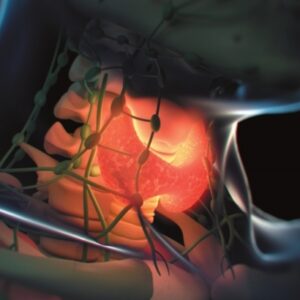Author: Forum News
A common occurrence you should know about
The thyroid is a large, butterflyshaped gland located at the front part of the neck in the midline. It usually drapes over the windpipe and mostly sits above the collarbone and below the Adam’s apple. It produces and stores a vital hormone that has wide-ranging metabolic effects in the body. Thyroid nodules are abnormal growths that develop within, but separate from, the normal surrounding thyroid gland tissue. At present, it is unclear why most thyroid nodules develop. However, certain inflammatory conditions of the thyroid and iodine deficiency are two ailments that may predispose an individual to the development of a nodule.
Thyroid nodules are quite common.

According to the American Thyroid Association, it is estimated that roughly half of the general population will develop at least one thyroid nodule by age 60. Nodules can be identified via physical examination or by imaging (e.g., ultrasound). Most thyroid nodules will not produce any symptoms initially. Symptoms usually develop once the nodule gets large enough to push on other structures in the neck including the esophagus (causing swallowing difficulty) or the windpipe (causing breathing problems). At this point, the nodule would likely be large enough to be observed through the neck. Changes in the voice are also of some concern because that may suggest that the nodule is not benign (not noncancerous).
The primary question, once a thyroid nodule is detected, is whether that nodule harbors malignancy. Fortunately, approximately 90-95 percent of thyroid nodules are noncancerous. When a thyroid nodule is being evaluated, it is important to look for risk factors that may be associated with an increased possibility of a thyroid cancer. Such risk factors include the following: age (people younger than 20 or older than 60 are more likely to have cancerous nodules), size (nodules greater than four centimeters are more suspicious), rapid growth of the nodule, enlarged lymph nodes in the neck, and associated breathing, swallowing or voicing difficulties. Prior radiation exposure to the neck and having a first-degree relative with thyroid cancer are also potential red flags.
Once a thyroid nodule is detected on physical examination, the next step is to obtain imaging. There are many types of X-rays that can evaluate a thyroid nodule. The preferred modality, however, is ultrasound, which offers very useful information on the size and number of thyroid nodules. It can also offer some clues as to whether the nodule may be cancerous depending on certain ultrasound characteristics. Thyroid function blood work is also a key component of the workup. A misconception I have frequently encountered in my practice is the thought that normal thyroid function equates to a normal thyroid without any cancer. It is important to understand that thyroid function tests only provide information on whether the amount of hormone the thyroid is producing is adequate. It does not, however, offer any insight as to whether or not there are cancerous cells within a nodule. In fact, it is not unusual to find normal thyroid function in the setting of thyroid cancer.
Further evaluation of the thyroid nodule is directed by the results of the ultrasound and thyroid function testing. For nodules over 1-1.5 centimeters in size, a minimally invasive technique called fine needle aspiration (FNA) may be offered. This involves inserting a very small needle directly into the nodule, drawing cells out from the nodule and placing them on a microscope slide. The slides are then sent to a medical pathologist for evaluation. In some instances, ultrasound is used to guide the needle into the nodule. Studies have demonstrated that ultrasound guidance increases the diagnostic yield of FNA in some cases.
After obtaining an FNA result, I usually bring the patient back to my officeto discuss the findings and my recommendations. An important concept to understand is that while FNA is extremely reliable, it is by no means foolproof. If the FNA result suggests that the nodule is benign, and the patient is without obvious clinical risk factors for malignancy, it is usually reasonable to simply observe the nodule with serial ultrasound examinations. If the nodule is not changing in size or character over time, one can be more confident in the benign result suggested by the FNA. In some cases, the FNA result falls into the indeterminate category, at which time a diagnostic thyroid surgery may be offered in order to obtain a firm diagnosis. If the FNA result suggests a malignancy, further evaluation is usually recommended with surgical removal of the entire thyroid being the definitive treatment option in many cases.
In summary, thyroid nodules are a common finding. Fortunately, most nodules cause no significant symptoms and do not represent thyroid cancer. Of note, January is Thyroid Awareness Month, which makes for an appropriate time to see your ENT for evaluation if you have a suspected thyroid nodule.
Dr. Chuka Ifeanyi is an ear, nose and throat specialist at Highland Clinic. Dr. Ifeanyi specializes in the diagnosis and treatment of disorders affecting the ear, nose, throat, and the head and neck of both children and adults. He is accepting new patients and can be reached at (318) 798-4440; located at 1455 East Bert Kouns Industrial Loop, Suite 206, Shreveport, LA 71105. Visit http://www. highlandclinic.com/staff/chuka-v-ifeanyi-m-d for more information.


